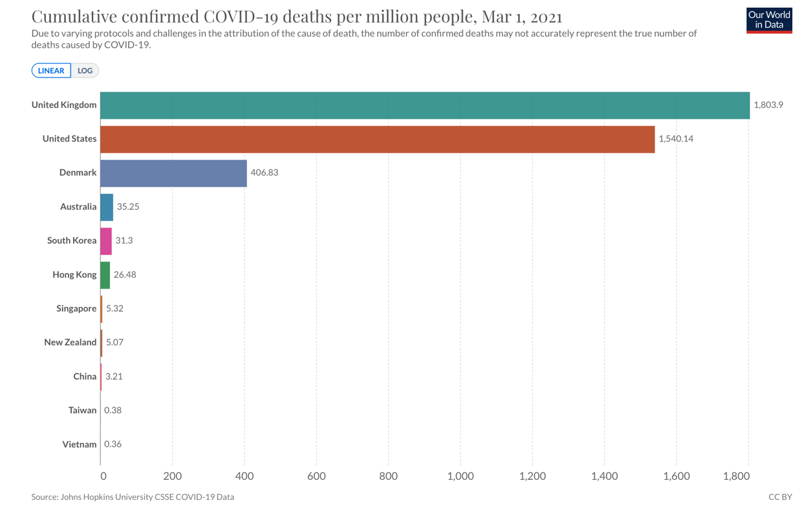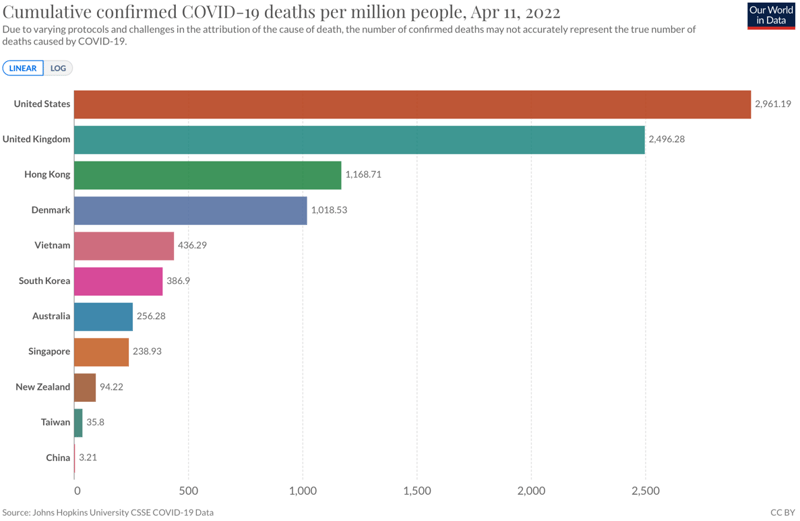The Covid-19 pandemic can be considered in two different phases: Pre-vaccine and post-vaccine. We have very good evidence that until the availability of vaccines, elimination was the best strategy.

On March 1 2021, the HK vaccine program was rolled out online. The benefit was clearly visible in the total Covid deaths in the elimination countries (Australia-Vietnam above). There was a significant discrepancy between countries which pursued suppress and lift strategies. Compare Denmark and the UK/USA at this time.
Comparing mortality rates can be difficult in evolving epidemics, we explain this issue and the difference between case fatality and infection fatality rates in an article here.
In a review of articles written since vaccinations became available in Hong Kong, Dr Owens assesses why Hong Kong failed to capitalize on the initial advantages of zero Covid. He considers the factors which explain the significant increase in mortality in Hong Kong in the first quarter of 2022.

April 2022 much of the early benefit has been lost and Hong Kong has significantly higher cumulative mortality than other elimination countries.
Failure to vaccinate high levels of the elderly and vulnerable was ultimately responsible for a significant amount of the excess mortality in Hong Kong. The failure to have a backup plan and in particular the delay in the pivot towards mitigation, in addition to policy decisions made in December 2021 to February 2022 overloaded the hospital system and resulted in a significant number of unnecessary deaths. Our review of the Hong Kong response is available here.
As anticipated the Omicron BA.2 wave has burned through Hong Kong over the last two months. This was predictable based upon a fundamental understanding of both epidemiology and the biology of Omicron.
Epidemiological data suggests that the Omicron wave peaked in Hong Kong earlier this week. This means that we are already at herd immunity. It is important to understand that herd immunity exists in a particular state. By mid-April we will have had something close to 5 million infections. This will be enough to bring the epidemic under control under the current social distancing regulations.
~ Newsletter March 11 2022
We have consistently argued for the benefits of vaccination. We continue to advocate for vaccination including in children. However, there is no scientific or ethical argument to coerce vaccination in youngsters and there is no reason to tie in-person teaching to vaccination rates. One consistent error in the Hong Kong public health response has been a failure to adapt to evolving evidence, indeed a tendency to pursue public health measures and restrictions at odds with the science used to justify them. The focus on the biologically impossible concept of herd immunity by vaccination alone led us to drive vaccination rates in the young rather than to address the elephant in the room, which was the unvaccinated vulnerable elderly. Basing our policies on a percentage of the total population being vaccinated made no scientific sense. Vaccinations are not as good at preventing Covid infections but they are excellent at reducing the risk of people becoming seriously ill or dying. We now know that BioNTech is a better vaccine overall, being more effective against transmission, mild disease and after only two shots. However, three shots of both BioNTech and Sinovac give 98% protection against death and severe disease.
Likewise the current border controls with hotel quarantine and flight bans are actively damaging public health in our city by damaging both the economy and the trust which is generated through evidence-based public policy. Every public health intervention carries a cost and unintended consequences. We are not advocating for open borders to make holiday travel and life easier for our patients. Excessive focus on the risks of the disease ignores the potential impact on the rest of the population. Pandemics always aggravate the impact of social inequality. The poorest children fall behind in education and the lowest-paid workers are most likely to be both unemployed and impacted (physically and psychologically) by the disease. In population terms, poverty and social inequality are the greatest drivers of poor health. The damage caused to population health in Hong Kong at this stage of the epidemic will be significantly greater from the economic impact of the public health measures than from the disease itself. We must protect the vulnerable, both young and old. It is a balance.
One major advance in the management of Covid is the development of novel antiviral drugs. These drugs are being used in Hong Kong and their effectiveness is already having a significant positive impact. The drugs are all provided via the government. As members of the voluntary vaccination scheme, doctors at OT&P have access to a limited supply of drugs which can be dispensed according to protocols based upon risk. Individuals in high risk groups testing positive for Covid are eligible for treatment. The protocols and availability of drug treatment will evolve over the coming weeks. We will continue to update our website. Please contact your doctor directly if you have any questions around this or any other area of Covid management.
Apart from the short-term risks of the disease we are increasingly understanding the impact of Long Covid on individuals and populations. Covid is a multisystem inflammatory disease and we have increasing evidence of long-term complications from international populations. We have produced a Long Covid resource centre which we will keep up to date as evidence evolves. Long Covid information is available here.
The pandemic has changed many things in our daily lives. It has accelerated previous trends towards digital communication and reinforced the importance of reliable information. Until March 1, 2021 we had received a total of 140K views to the OT&P Chinese language website, in the interim we have had a further 2.5 million views to the Chinese site alone, the vast majority for our Covid-19 public health resources. We are pleased to announce the rollout of the OT&P Digital App. Instructions for downloading and setting up the app are available here. In the initial version our patients can register and link to a digital patient card. This allows easier online booking and provides a QR code for a quicker check-in. All our online resources will be available through the App. Over the next few months we will be integrating optionality to integrate personalised health data from wearables in addition to other recorded metrics such as blood pressure and blood sugar levels. Over the next 12 months we plan to develop the App to allow access to historical records and investigations and telemedicine functionality.
We wish all of our patients a healthy Easter break. We are looking forwards to the return of the noise of children playing in the playgrounds and the gradual return of a more normal life in Hong Kong.
 Central General Practice
Central General Practice
 Repulse Bay
Repulse Bay
 Clearwater Bay
Clearwater Bay
 Central Specialist Clinic
Central Specialist Clinic
 BodyWorX Clinic
BodyWorX Clinic
 MindWorX Clinic
MindWorX Clinic
 Partner Clinics
Partner Clinics
 Family Clinic
Family Clinic
 OT&P Annerley Midwives Clinic
OT&P Annerley Midwives Clinic
